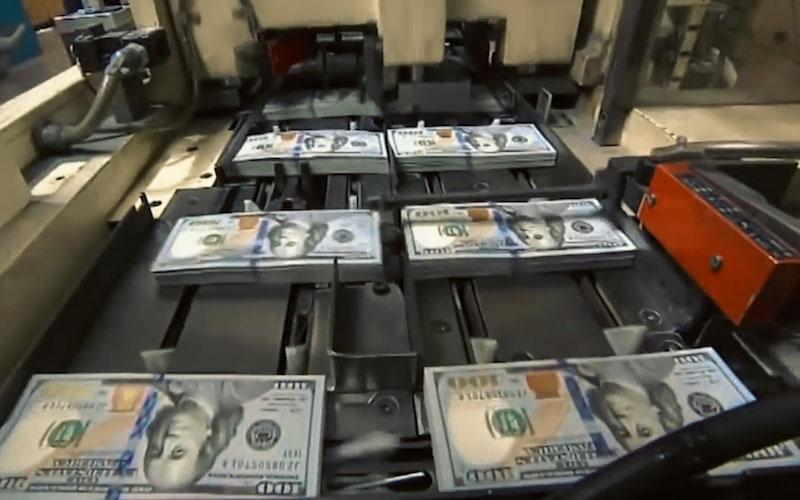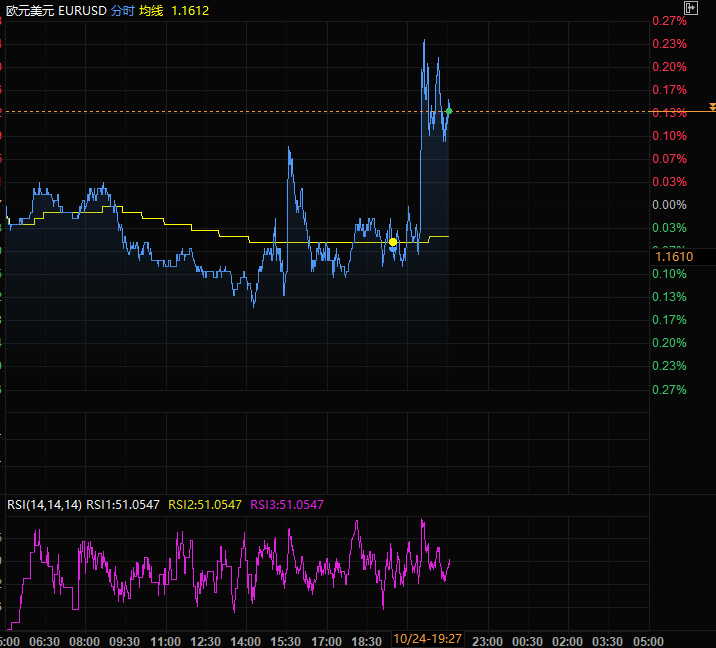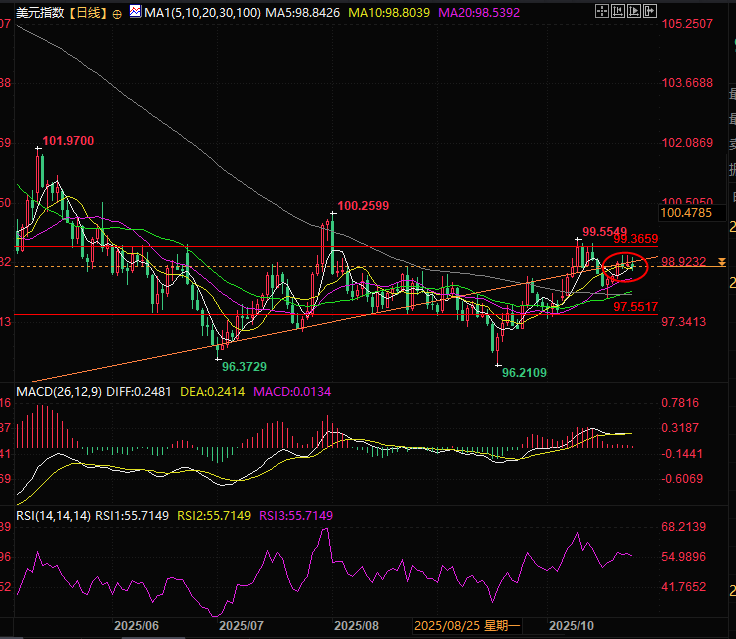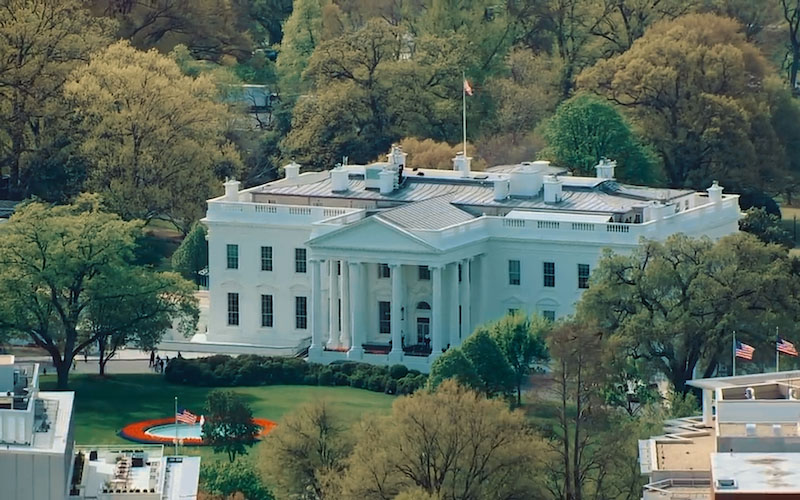US inflation has unexpectedly turned negative, opening the door to interest rate cuts and sparking a global asset frenzy?
2025-10-24 21:36:56
The market generally expected that the year-on-year increase in the core CPI in September would be the same as the previous month, maintaining at 3.1%, indicating that the market's expectations for core inflation were relatively stable. However, the actual figure of 3.0% after the announcement was lower than market expectations. It is worth noting that most Federal Reserve officials believe that there is no need to pay too much attention to this increase in inflation. Many officials said that the impact of tariffs on inflation is temporary, which is actually reserving an excuse in advance if inflation exceeds expectations. If inflation falls short of expectations, the market will have more room for imagination about the Fed's subsequent interest rate cuts.
Affected by this, the US dollar index fell rapidly by 0.3% and is currently trading around 98.86, down 0.05%.

The euro is celebrating and taking the opportunity to rise
Earlier on Friday, the Eurozone's preliminary PMI performed better than market expectations, but the euro still lacked effective upward momentum and showed no significant performance; at the same time, France's CAC40 and the European STOXX 600 indices all opened high and fell. However, with the release of US inflation data, the euro, along with the unexpected part of the morning's PMI, was relieved, rising by more than 0.3% in one fell swoop, and the indices of various countries also directly hit intraday highs.
In the government bond market, except for Japan's 10-year government bond yield which fell by 1 basis point, the government bond yields of other major economies mostly rose, and the global risk-free interest rate was generally strong, suggesting a slight increase in market risk appetite.

(Euro/Dollar daily chart)
Fed to focus more on labor market
From the perspective of risk balance, the risk of further deterioration in the labor market has become the focus of the entire market, which also provides support for the Federal Reserve to maintain its loose tendency.
The market has basically digested the expectation of the Federal Reserve cutting interest rates next week, and since the quiet period before the meeting has officially begun, Federal Reserve officials can hardly change market expectations through public statements, and short-term policy expectations will remain stable.
The Federal Reserve is in a difficult situation of having to choose the lesser of two evils between inflation and growth, and can only find excuses for inflation. After the release of this CPI, the Federal Reserve will reduce its inflation-related worries and focus on economic growth.
Today's release of the US September core CPI, excluding housing, also missed expectations, potentially exacerbating the dollar's downward trend. The subsequent October preliminary US PMI, combined with the final University of Michigan Consumer Confidence Index and the Kansas City Fed Services Survey, will have limited market impact. Barring a significant, unexpected revision in the data, the current market trend is unlikely to change.
At the same time, the market needs to pay close attention to the Conference Board Consumer Confidence Index next Tuesday as a supplement to the US economic growth data.
A weaker dollar will provide a loose monetary environment globally
The release of the US CPI that was lower than expected is a good medicine for the global economy. Affected by the US CPI that was lower than expected, gold, US stocks and European stock markets all rose.
Krishna Srinivasan, director of the International Monetary Fund's (IMF) Asia and Pacific Department, recently warned in an interview: If the US dollar strengthens and interest rates rise, leading to a tightening of the global financial environment, the resilience of Asian economies in resisting US tariffs may face severe challenges, and we need to be vigilant about the impact of changes in the external environment on the regional economy.
Srinivasan pointed out that if the Federal Reserve continues to implement its interest rate cut policy and the US dollar weakens accordingly, Asian central banks will gain policy space - they can support their own economies by easing monetary policy without worrying about the risk of capital outflow, which will provide a favorable external environment for the Asian economy.
Previously, the market environment of low interest rates and declining long-term yields helped Asian governments and companies obtain financing at low cost, thereby alleviating the economic pressure brought about by the US tariffs to a certain extent.
IMF Asia-Pacific Economic Outlook
The IMF's latest "Asia Pacific Regional Economic Outlook 2025" report released on Friday showed that the economic growth rate in the Asia-Pacific region is expected to reach 4.5% in 2025, which is slightly lower than last year's 4.6%, but 0.6 percentage points higher than the forecast in April. The upward momentum is mainly due to the strong export performance of Asian economies. In order to avoid higher US tariffs, many companies have accelerated the shipment of goods and released export demand in advance.
However, the report also clearly warned that the Asia-Pacific economy faces significant downside risks, with growth expected to slow to 4.1% in 2026 and growth momentum likely to gradually weaken.
In terms of inflation, even in the context of rising demand in the post-epidemic era and the Russia-Ukraine conflict pushing up raw material prices, prices in Asia continue to be lower than in other parts of the world.
Srinivasan pointed out that this phenomenon shows that Asian central banks have the ability to stabilize inflation expectations and lower inflation. The core reason is that the public trusts that these central banks can be free from government intervention and maintain policy independence.
Summarize:
"The super core services CPI, excluding housing, is a key indicator of underlying inflation trends in the United States. The year-on-year increase in this indicator remained at 3.2% for the second consecutive month in August, indicating that the progress of the United States towards the Federal Reserve's 2% inflation target has stalled. The decline to 3.1% this month shows that the progress of controlling inflation has not been affected.
The current upward risk of prices has not yet intensified further, which leaves the Federal Reserve with huge policy space to cut interest rates by another 25 basis points or even more next week (lowering the target interest rate range to 3.75%-4.00%).
Furthermore, restrictive monetary policy could exacerbate the already fragile employment situation and make further cuts in federal funds rate futures a certainty. From a fundamental perspective, the dollar's downward trend has not changed, and a short-term rebound may be difficult to sustain.
Technical Analysis:
It can be seen from the daily line of the US dollar index that although the US dollar index continued to rebound this week, it still closed below the key trend line for three consecutive days (the neckline of the previous head and shoulders top pattern). At the same time, this rebound has not yet risen above the 100-plus bearish line, and has not even risen above the key level of 99.55, the 50% percentile of the non-farm payroll line.
To sum up, the US dollar index is still in a rebound pattern and there is no sign of reversal.

(Daily chart of the US dollar index, source: Yihuitong)
At 21:29 Beijing time, the US dollar index is currently at 98.86.
- Risk Warning and Disclaimer
- The market involves risk, and trading may not be suitable for all investors. This article is for reference only and does not constitute personal investment advice, nor does it take into account certain users’ specific investment objectives, financial situation, or other needs. Any investment decisions made based on this information are at your own risk.





















